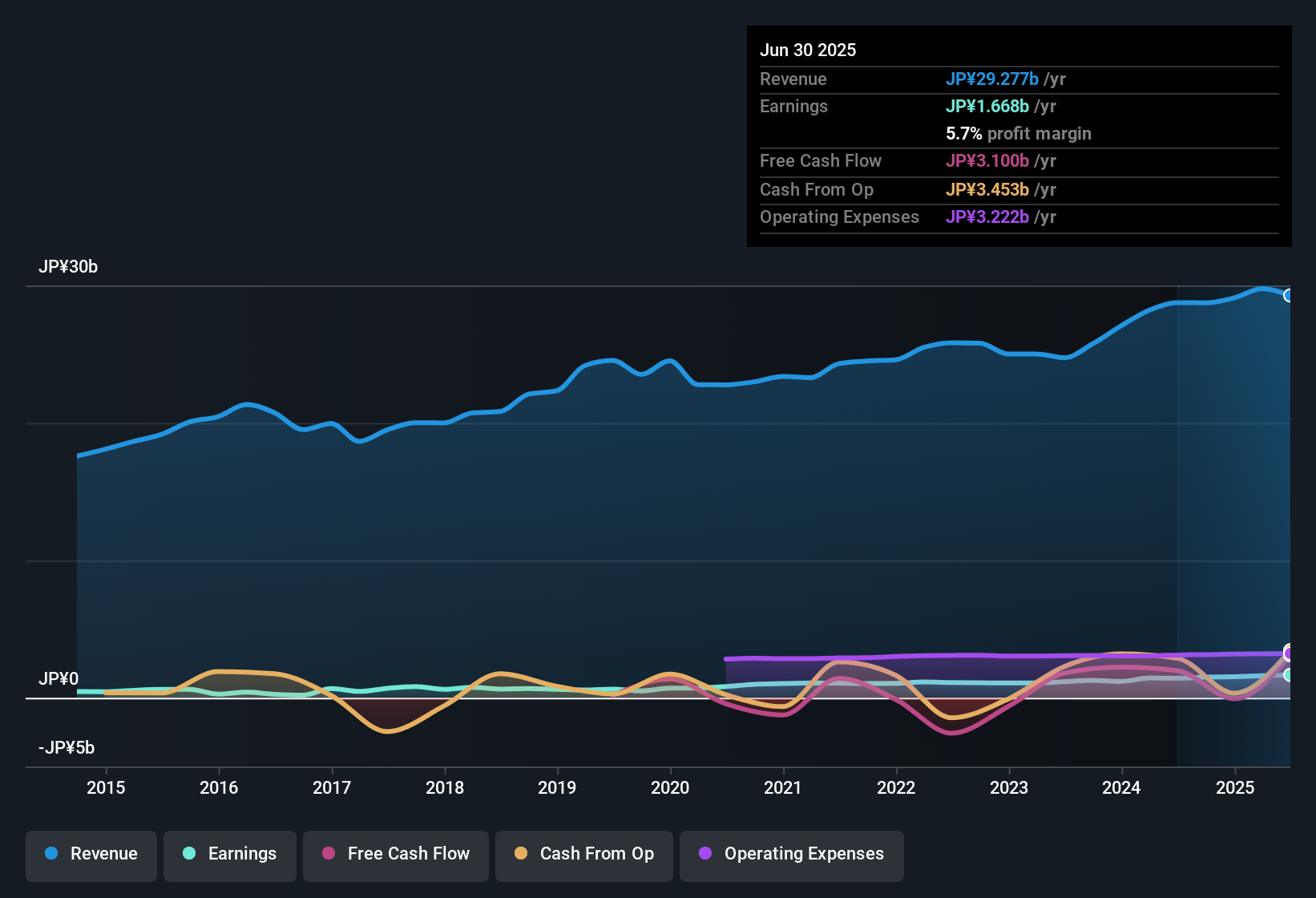Investors were disappointed with Seiko Electric Co., Ltd.'s (TSE:6653) earnings, despite the strong profit numbers. We did some digging and found some worrying underlying problems.

Zooming In On Seiko Electric's Earnings
As finance nerds would already know, the accrual ratio from cashflow is a key measure for assessing how well a company's free cash flow (FCF) matches its profit. In plain english, this ratio subtracts FCF from net profit, and divides that number by the company's average operating assets over that period. The ratio shows us how much a company's profit exceeds its FCF.
Therefore, it's actually considered a good thing when a company has a negative accrual ratio, but a bad thing if its accrual ratio is positive. That is not intended to imply we should worry about a positive accrual ratio, but it's worth noting where the accrual ratio is rather high. To quote a 2014 paper by Lewellen and Resutek, "firms with higher accruals tend to be less profitable in the future".
Over the twelve months to June 2025, Seiko Electric recorded an accrual ratio of -0.12. That implies it has good cash conversion, and implies that its free cash flow solidly exceeded its profit last year. To wit, it produced free cash flow of JP¥3.1b during the period, dwarfing its reported profit of JP¥1.67b. Seiko Electric shareholders are no doubt pleased that free cash flow improved over the last twelve months. Having said that, there is more to consider. We must also consider the impact of unusual items on statutory profit (and thus the accrual ratio), as well as note the ramifications of the company issuing new shares.
See our latest analysis for Seiko Electric
That might leave you wondering what analysts are forecasting in terms of future profitability. Luckily, you can click here to see an interactive graph depicting future profitability, based on their estimates.
In order to understand the potential for per share returns, it is essential to consider how much a company is diluting shareholders. Seiko Electric expanded the number of shares on issue by 11% over the last year. That means its earnings are split among a greater number of shares. Per share metrics like EPS help us understand how much actual shareholders are benefitting from the company's profits, while the net income level gives us a better view of the company's absolute size. You can see a chart of Seiko Electric's EPS by clicking here.
A Look At The Impact Of Seiko Electric's Dilution On Its Earnings Per Share (EPS)
Seiko Electric has improved its profit over the last three years, with an annualized gain of 50% in that time. But EPS was only up 40% per year, in the exact same period. And over the last 12 months, the company grew its profit by 17%. But in comparison, EPS only increased by 9.1% over the same period. So you can see that the dilution has had a bit of an impact on shareholders.
In the long term, earnings per share growth should beget share price growth. So it will certainly be a positive for shareholders if Seiko Electric can grow EPS persistently. However, if its profit increases while its earnings per share stay flat (or even fall) then shareholders might not see much benefit. For that reason, you could say that EPS is more important that net income in the long run, assuming the goal is to assess whether a company's share price might grow.
The Impact Of Unusual Items On Profit
While the accrual ratio might bode well, we also note that Seiko Electric's profit was boosted by unusual items worth JP¥443m in the last twelve months. While we like to see profit increases, we tend to be a little more cautious when unusual items have made a big contribution. When we analysed the vast majority of listed companies worldwide, we found that significant unusual items are often not repeated. Which is hardly surprising, given the name. If Seiko Electric doesn't see that contribution repeat, then all else being equal we'd expect its profit to drop over the current year.
Our Take On Seiko Electric's Profit Performance
Summing up, Seiko Electric's accrual ratio suggests that its statutory earnings are well matched by cash flow while its unusual items boosted the profit in a way that might not be repeated. Further, the dilution means profits are now split more ways. Based on these factors, we think that Seiko Electric's statutory profits probably make it seem better than it is on an underlying level. Keep in mind, when it comes to analysing a stock it's worth noting the risks involved. Case in point: We've spotted 1 warning sign for Seiko Electric you should be aware of.
In this article we've looked at a number of factors that can impair the utility of profit numbers, and we've come away cautious. But there is always more to discover if you are capable of focussing your mind on minutiae. For example, many people consider a high return on equity as an indication of favorable business economics, while others like to 'follow the money' and search out stocks that insiders are buying. So you may wish to see this free collection of companies boasting high return on equity, or this list of stocks with high insider ownership.
New: Manage All Your Stock Portfolios in One Place
We've created the ultimate portfolio companion for stock investors, and it's free.
• Connect an unlimited number of Portfolios and see your total in one currency
• Be alerted to new Warning Signs or Risks via email or mobile
• Track the Fair Value of your stocks
Have feedback on this article? Concerned about the content? Get in touch with us directly. Alternatively, email editorial-team (at) simplywallst.com.
This article by Simply Wall St is general in nature. We provide commentary based on historical data and analyst forecasts only using an unbiased methodology and our articles are not intended to be financial advice. It does not constitute a recommendation to buy or sell any stock, and does not take account of your objectives, or your financial situation. We aim to bring you long-term focused analysis driven by fundamental data. Note that our analysis may not factor in the latest price-sensitive company announcements or qualitative material. Simply Wall St has no position in any stocks mentioned.
About TSE:6653
Seiko Electric
Operates in the field of power system, and environmental energy and control system in Japan.
Flawless balance sheet established dividend payer.
Market Insights
Community Narratives



